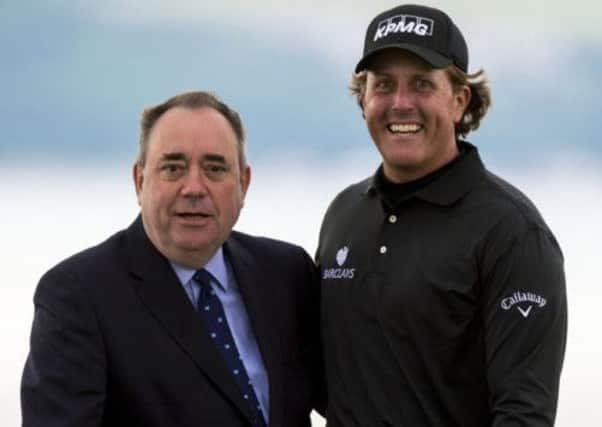Martin Dempster: Important to let our light shine


What, for example, can spectators expect in terms of a field in Aberdeen next year then, in two out of the three years after that, on both the east and west coasts at venues yet to determined?
The reason I ask is because, judging from a post on www.scotsman.com over the weekend, some people have a misconception about the event having changed as far as the standard of the line-up is concerned, considering it is one that occupies one of golf’s prime spots in its pre-Open Championship week.
Advertisement
Hide AdAdvertisement
Hide Ad“Take a look at this year’s field and count the stellar big names,” wrote an unnamed individual. “Now find a programme from five or six years ago and compare the two. The big names have stopped coming.”
Finding a programme was impossible but a beauty of the internet is you can check these things out with a click of the button, so, intrigued by that claim, I did.
Six years ago, when the event was held at Loch Lomond and won by Frenchman Gregory Havret, the only “stellar big names” in the field were Mickelson – who lost in a play-off that year – and Ernie Els, a winner of the event as well.
It also included the likes of Luke Donald, Ian Poulter, Lee Westwood and Graeme McDowell, but none of them were major crowd-pullers at the time and, with the exception of perhaps McDowell as a major champion, they’re still not.
What about the Scottish Open crowd-pullers a decade ago? Guess what? Another click revealed they were Els and Mickelson again, though John Daly was at Loch Lomond on that occasion, too.
Where some people may have become disappointed about the strength of the field at Castle Stuart during its three-year stint in the Highlands was that the move to a links course was hyped.
For some reason, we all believed that a posse of players from the world’s top 20 would add the event to their schedules and the Americans would be there en masse.
Three years ago, Els and Mickelson were the star attractions, ditto two years ago and yet again last week. In short, the Scottish Open owes an enormous debt of gratitude to these two individuals. It would be wrong, though, to view their staunch support in the past as a guarantee they will be at Royal Aberdeen in 12 months, the Renaissance Club or wherever in 2015, and anywhere else thereafter.
Advertisement
Hide AdAdvertisement
Hide AdEls and Mickelson (the proud new champion is now likely to be in the Granite City) have more than done their bit for the Scottish Open and should not be shouldered with the burden of being the ones expected to sprinkle the stardust.
As a traditional links, it will be fascinating to see who turns up at Royal Aberdeen and, having already talked about it in glowing terms, it would be a surprise if McDowell isn’t among the early entries next year.
In truth, though, there’s no guarantee that field will boast any more than two of the world’s top 25 – the figure in Inverness last week and the reason it carried its lowest ranking points in 13 years – because more of the game’s leading lights seem keen to keep their powder dry these days before majors.
Like it or not, the line-up for the Scottish Open isn’t any stronger than the French and Irish equivalents or the BMW PGA Championship, which only occasionally includes an American and, even then, it’s likely to be someone who’s lost his PGA Tour card.
We should be happy with what we’ve got, especially as the event, which was under threat not so long ago, is now on such a firm footing with Aberdeen Asset Management, the Scottish Government and the European Tour having extended their partnership until 2017.
No matter what you think of him, First Minister Alex Salmond, a keen golfer, deserves a big pat on the back for the part he has played in that, as does Aberdeen chief executive Martin Gilbert, another of the game’s aficionados.
Add in the fact that, as part of the 2014 Ryder Cup legacy, a commitment has been made to stage three more events – the Scottish Hydro Challenge, Ladies Scottish Open and the Scottish Seniors’ Open – through to 2018 and that the Women’s British Open is set to be staged here four times between now and 2019 and it is easy to see why envious glances are being cast in the country’s direction.
“You’ve got to remember that two years ago, the Scottish Open was in real jeopardy,” said Salmond of the event being left without a title sponsor after Barclays ended a nine-year stint. “I was determined it wouldn’t stop.
Advertisement
Hide AdAdvertisement
Hide Ad“Would it (the Government and Aberdeen backing for the event) happen if I didn’t like golf or they didn’t like golf? I’d like to think it would happen for business purposes. We are putting in a million and the minimum return is five million, so a five-to-one ratio is good business. Golf probably has a longer-term commitment than any public service in the country. They seem to go from spending review to spending review.
“The key is not to stop once the Ryder Cup is over. It’s not stopping the day after we celebrate the next European win at Gleneagles next year. I’m not decrying what went in Ireland and Wales (where tournaments dropped off schedules post-Ryder Cup), but it’s a lesson we wanted to learn from.”
So let’s stop claiming things aren’t as rosy as they used to be when it comes to events like the Scottish Open.